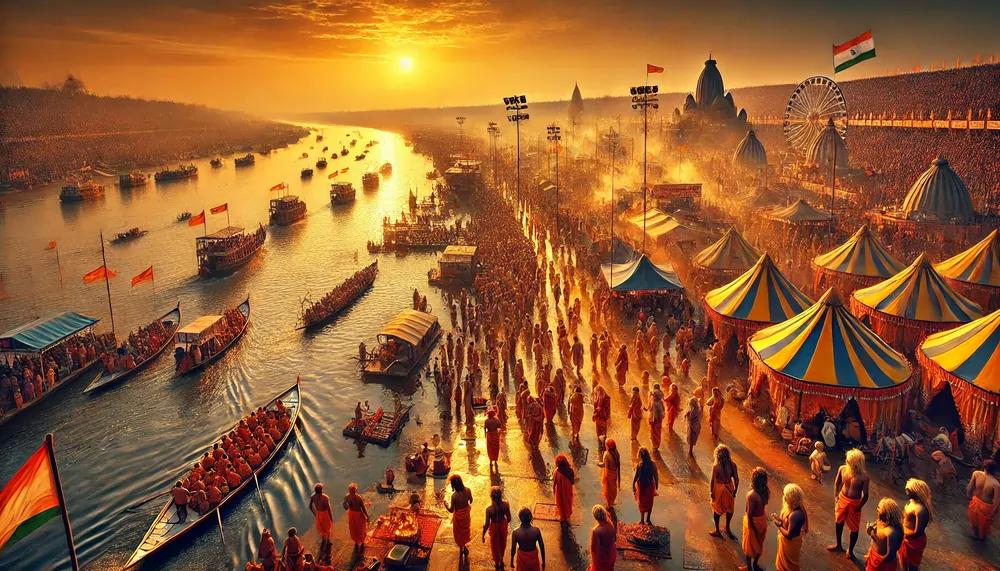It’s MahaKumbh Time…Go For Moksha…Saying it again, Its MahaKumbh. Time for the world’s largest cultural / religious congregation. Masses of all hues all throughout the world congregate, as now, for the holy dip as many times as possible within the stipulated time so that thre is shuddhikaran (reformation) of all types, new incarnation in a reincarnated form takes place in reality for Moksha Prapti, a must for a human being, come what may. it’s a great prapti (achievement), according to Sanatan.
Due to the confluence of Ganga, Yamuna, and Saraswati at Allahabad, the city is known as the Sangam city. The confluence is of great religious importance in the area. Therefore, the city is often regarded as the Abode of God and is visited by various pilgrims. The earlier settlements of the Aryans were established in this city, then known as Prayag. All sins are cleaned with entry in Prayag. Prayagraj is one of the historic and mythological cities of India with glorious past and present. It continues to enjoy the distinction of being a place of haunting and lasting memories. {According to legends, Vishnu was carrying a Kumbh (pot) of amrit (nectar), when a scuffle broke out and four drops were spilled. They fell to earth at the four Tirthas of Prayag, Haridwar, Nasik and Ujjain. A tirtha is a place where the devout can attain salvation}.
Prayag in modern-day Allahabad is believed to be the most important pilgrimage centre for Hindus. As Jayant ran, the amrita spilt at four spots: Haridwar, Prayagraj, Ujjain, and Nashik-Trimbakeshwar. He ran for 12 days, and as one day of the Devas is equal to one year of humans, Kumbh Mela is celebrated at these locations every 12 years, based on the relative positions of the Sun, the Moon, and Jupiter. As Jayant ran, the amrita spilt at four spots: Haridwar, Prayagraj, Ujjain, and Nashik-Trimbakeshwar. He ran for 12 days, and as one day of the Devas is equal to one year of humans, Kumbh Mela is celebrated at these locations every 12 years, based on the relative positions of the Sun, the Moon, and Jupiter. Prayagraj is believed to be the most important pilgrimage centre for Hindus. Traditionally river confluences are regarded as auspicious places, but in Sangam, the significance of the confluence is most pious because here, the holy Ganga, Yamuna and the mythical Saraswati meet to become one. This location is where, according to Hindu legend, Brahma performed the first fire sacrifice. Once the ancient Hindu holy site of Prayag, it still draws pilgrims, who come to bathe at the sangam every year during the Magh Mela festival.
Prayag in modern-day Allahabad is believed to be the most important pilgrimage centre for Hindus. Traditionally river confluences are regarded as auspicious places, but in Sangam, the significance of the confluence is most pious because here, the holy Ganga, Yamuna and the mythical Saraswati meet to become one.
According to legends, Vishnu was carrying a Kumbh (pot) of amrit (nectar), when a scuffle broke out and four drops were spilled. They fell to earth at the four Tirthas of Prayag, Haridwar, Nasik and Ujjain. A tirtha is a place where the devout can attain salvation. The event is commemorated every three years by the Kumbh Mela, held at each tirtha in turn; the Sangam is known as Tirtharaj, the ‘King of Tirthas’ and here the Kumbh is held once in every twelve years, which is the greatest and holiest of all.
The Maha Kumbh Mela is the largest religious congregation in India, attended by millions. The over month-long fair is marked by the construction of a massive tented township, complete with cottages, huts, platforms, civic facilities, administrative and security measures. It is organized immaculately by the government, the local authorities and the police. The mela is especially renowned for the presence of an extraordinary array of religious ascetics – sadhus and mahants – enticed from remote hideaways in forests, mountains and caves. Once astrologers have determined the propitious bathing time or Kumbhayog, the first to hit the water is by legions of Naga Sadhus or Naga Babas, who cover their naked bodies with ash and wear hair in long dreadlocks. The sadhus, who see themselves as guardians of the faith, approach the confluence at the scheduled time with all the pomp and bravado of a charging army. The most recent Maha Kumbh Mela was held in 2013 and the next is due in 2025.
This is the point where the brown water of the Ganga meets the green water of the Yamuna, along with the mythical Saraswati, which remains unseen but believed to run underground. It is located about 7 km from Civil Lines, overlooked by the eastern ramparts of the Akbar Fort.
Wide flood plains and muddy banks protrude towards the sacred Sangam. At the mid-river point priests perch on small platforms to perform puja and assist the devout in their ritual ablutions in the shallow waters. A dip in the Sangam water is supposed to be the holiest of the holy pilgrimages for the devout Hindu. Boats to the Sangam can be rented by pilgrims and tourists alike at the ghat near the fort. It is during the Maha Kumbh/Kumbh that the Sangam truly comes alive, attracting the devout from all across the country.
The Mahakumbh Mela is a Hindu festival that originated from the ancient legend of Samudra Manthan, or the churning of the cosmic ocean. Here's some background on the Mahakumbh Mela:
According to Hindu mythology, the gods and demons churned the ocean to obtain amrita, the nectar of immortality. During this process, drops of the nectar fell to Earth at four locations, which became the sites of the Kumbh Mela.
The word "Kumbh" means "pot" and symbolizes the container that held the elixir.
The Mahakumbh Mela is held every 12 years in Prayagraj, Uttar Pradesh. The Kumbh Mela is held every 3 years in four different locations, including Haridwar, Ujjain, and Nashik.
According to Hindu mythology, the Kumbh Mela is timed based on the alignment of the sun, moon, and Jupiter. This alignment is believed to create a powerful spiritual energy.
The 2025 Mahakumbh Mela is special because of its religious significance and the rare celestial alignment that occurs only once in 144 years
The festival is traditionally credited to the 8th-century Hindu philosopher and saint Adi Shankara, as a part of his efforts to start major Hindu gatherings for philosophical discussions and debates along with Hindu monasteries across the Indian subcontinent.[1] However, there is no historical literary evidence of these mass pilgrimages called "Kumbha Mela" prior to the 19th century. There is ample evidence in historical manuscripts[11] and inscriptions[12] of an annual Magha Mela in Hinduism – with periodic larger gatherings after 6 or 12 years – where pilgrims gathered in massive numbers and where one of the rituals included a sacred dip in a river or holy tank. According to Kama MacLean, the socio-political developments during the colonial era and a reaction to Orientalism led to the rebranding and remobilisation of the ancient Magha Mela as the modern era Kumbh Mela, particularly after the Indian Rebellion of 1857.

